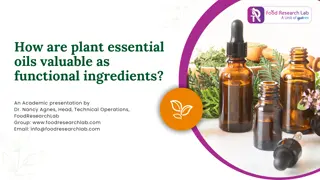Understanding Food Safety Legislation and Supervisory Roles in the Hospitality Industry
Explore the crucial role of supervisors in upholding food safety legislation in hospitality settings. Learn about the principles, processes, and responsibilities related to food safety and health regulations. Understand the significance of HACCP, government involvement in food safety, and employer and employee duties in maintaining food safety standards.
Download Presentation

Please find below an Image/Link to download the presentation.
The content on the website is provided AS IS for your information and personal use only. It may not be sold, licensed, or shared on other websites without obtaining consent from the author. Download presentation by click this link. If you encounter any issues during the download, it is possible that the publisher has removed the file from their server.
E N D
Presentation Transcript
Unit 315 Supervisory skills for the professional kitchen
Demonstrate knowledge and understanding of the principles, processes and procedures for food safety and health and safety in the workplace Apply knowledge and understanding of the principles, processes and procedures used in food safety and health and safety in a range of hospitality contexts Analyse, interpret and evaluate food safety and health and safety information to predict probable consequences and provide reasonable alternatives and solutions to food safety and health and safety issues in the workplace Make connections, use and integrate different principles, processes and procedures for food safety and health and safety in the workplace in order to justify and support judgements being made
Food safety legislation Food safety legislation, its purpose and aims, and the role of the supervisor in its application. The main legal frameworks, laws and offences relating to food safety and health and safety in the workplace: The Food Hygiene Regulations 2006, Regulation (EC) No. 852/2004 on the hygiene of foodstuffs, the Food Safety Act 1990, Food Premises (Registration) Regulations 1991.
Write down what you feel the role of a supervisor is in the work place What is the role of the legislation that is in place Explain what HACCP is What is the role of the Government with food safety?
The roles and responsibilities of government in their oversight of food legislation and support to hospitality businesses in the maintenance of food safety. Food standards agencies best practice advice and guidance food hygiene rating schemes food safety management guides. Local authorities/the environmental health practitioner (EHP): giving advice on food safety investigating complaints examining food in food premises taking samples of food for analysis educating owners of businesses taking enforcement action.
The scope of employer and employee responsibilities under food safety legislation and how individuals must understand the importance of their contribution to the maintenance of food safety. Employer: ensuring staff have the relevant skills, knowledge and resources required to carry out their work, implementing procedures to meet control points following relevant legislation and organisational policy. Employees: allocating and supervising food safety responsibilities, protecting own and others work against negative impacts, being vigilant for possible hazards, agreeing what is expected of others and holding them to account, knowing relevant legislation and other industry-specific regulations and codes of practice.
The purpose of food safety systems and how they can contribute to compliance with legislation and facilitate the introduction of the safe working practices required to maintain food safety. The role of food safety systems in the success of a hospitality business and the benefits and consequences of failure to introduce a system.
Hazard Analysis and Critical Control Point (HACCP) safer food, better business (SFBB)/CookSafe/Safe Catering enable hospitality and catering organisations to comply with the requirement for a documented food safety management system and to comply with legislation assist an organisation to implement systems and methods to keep food safe help an organisation to train staff help to protect an organisation's reputation help to improve an organisation s food hygiene rating score.
ensuring that proper safe working and food handling practices are in place and applied monitoring and recording of safe working and food handling practices the identification of critical control points and critical limits ensuring the effectiveness of control measures for different hazards knowing how different conditions impact on the effectiveness of control measures taking corrective actions and introducing measures for improvement.
the need for adjustment to food safety management procedures when a review indicates that control methods are ineffective, or if enforcement officers recommend or require changes factors or events that may require an immediate review and evaluation of the food safety procedures the importance of communicating to relevant staff any changes to the procedures and of monitoring and verifying new procedures.
The benefits of high standards of food safety and health and safety to the organisation. The consequences and costs associated with food poisoning outbreaks, accidents and ill health.
Types of contaminate: microbial physical chemical contaminants the transference of allergens.
raw food people equipment packaging air, dust and soil pests water.
The different types of bacteria, their characteristics, the conditions for their growth and the groups most susceptible to food poisoning.
the bacteria that cause food spoilage, not food poisoning yeasts, moulds, fungi or bacteria. Pathogenic bacteria: the bacteria that cause ill health when present in large numbers in food. Pathogenic bacteria:
nutrients warmth time moisture pH.
pregnant women the elderly young children people with chronic illness.
Salmonella: sources present in human and animal intestines foods commonly involved meat, poultry, milk, eggs, raw fruits and vegetables cause of and illness large number of bacteria on food, onset period of 12 72 hours with diarrhoea, fever, headache, abdominal cramps, vomiting lasting 1 7 days carrier status common control measures separation of raw and cooked foods, thorough cooking of meat and poultry, good personal hygiene, effective pest control, effective cleaning and disinfection. Salmonella:
sources present in human and animal intestines, soil, dust foods commonly involved meat products such as stews, casseroles and gravy cause of and illness toxins produced by bacteria multiplying quickly in meats that are slowly cooked, cooled slowly or cooked meat stored at ambient temperatures. Toxins produced when bacteria reach the intestines, causing a person to become sick. Onset period 8 22 hours, with abdominal pain and diarrhoea lasting 1 2 days carrier status not common control measures effective temperature controls when storing and cooking meat, separation of raw and cooked foods, effective cleaning and disinfection.
sources skin, ear, nose and throat of food handlers, raw milk foods commonly involved cooked meats, salads, cream cause of and illness toxins produced by the bacteria as they multiply on food. Onset period of 2 4 hours, with nausea, vomiting, diarrhoea, loss of appetite, severe abdominal cramps, mild fever lasting 24 hours carrier status common control measures good personal hygiene, temperature controls, effective cleaning and disinfection.
sources cereals, soil, dust foods commonly involved rice and rice dishes cause of and illness heat-resistant toxin caused by bacteria as they multiply in food. Onset period 1 5 hours, with nausea, vomiting, abdominal pain and some diarrhoea, lasting 12 24 hours carrier status none control measures thorough cooking and cooling of food, safe storage, effective cleaning and disinfection.
sources present in human and animal intestines, soil and sewage foods commonly involved raw meat, undercooked beefburgers, gravy, raw milk cause of and illness a toxin produced in the intestines. Onset period of 12 24 hours, with nausea carrier status common control measures separation of raw and cooked foods, good personal hygiene, effective temperature controls, effective cleaning and disinfection.
The importance of, and the procedures and processes for, the safe and effective storage and temperature control of ingredients for customers consumption. The role of the supervisor in the application, checking, monitoring and compliance of these controls. The corrective actions required to maintain controls and the consequences of inadequate control.
the importance of stock rotation use-by dates best-before dates stock rotation systems: first in, first out (FIFO)/last in, last out (LILO) foods exempt from date marking receiving deliveries and checking for damage product traceability.
cool and dry dark but with adequate artificial lighting adequate ventilation storage off the floor and away from walls storage in lidded containers.
siting access prevention of cross-contamination maintenance and cleaning. Freezers: siting access prevention of cross-contamination maintenance and cleaning defrosting. Thawing frozen food: defrost in a fridge or thawing cabinet protect thawing food against contamination cook immediately following thawing. Freezers: Thawing frozen food:
use of vehicles and/or containers transporting different types of food at the same time effective cleaning between loads keeping food at appropriate temperatures and allowing those temperatures to be monitored.
follow the manufacturers cooking instructions for food products (where applicable) preheat equipment before cooking never use the same utensils, plates or containers for raw and cooked or ready-to-eat food use of whole cuts or joints and cuts and joints of appropriate size ensure liquid dishes, gravy, soups, sauces and stews are simmering and stir them frequently ensure one of the following temperatures has been reached: 80 C for at least 6 seconds, 75 C for at least 30 seconds, 70 C for at least 2 minutes, 65 C for at least 10 minutes, 60 C for at least 45 minutes.
to prevent the growth of food poisoning bacteria complying with legislation maintaining safe standards maintaining the reputation of the business.
below 8 C and above 63 C reheated food 82 C (Scotland) 75 C (England) exceptions to temperature controls and regional variations.
in-place devices air temperature monitoring systems electronic probe thermometers methods of calibration.
taking fridge and freezer temperature daily taking product temperatures as required cleaning and disinfecting probe inserting probe between packs for fridge and freezer temperatures inserting into thickest part of products if undertaking product sampling recording all routine and product sampling temperatures reporting temperatures out of acceptable range.
The importance of, and the procedures and processes for, achieving and maintaining high standards of personal hygiene across all areas of a hospitality business. The role of the supervisor in the application, monitoring and correction of standards and the consequences of inadequate control.
Personal grooming: hair jewellery perfume makeup Clothing: washable or disposable light coloured no external pockets no outside clothing in food areas. Exclusion of food handlers: if suffering from sickness or diarrhoea with serious skin infections.
The importance of, and the procedures and processes for, the effective cleaning and disinfection of food production and service, areas, equipment and machinery, and the role of the supervisor in the application, checking and monitoring of cleanliness, and professional waste disposal in hospitality organisations.
food preparation areas work surfaces equipment utensils. Methods of cleaning and use of cleaning materials: detergents disinfecting sanitising disposable cloths colour-coded equipment cloths, brushes, mops correct use and storage of cleaning chemicals use of dishwashing machines. Methods of cleaning and use of cleaning materials:
pre-clean main clean intermediate rinse disinfection final rinse dry.
breaking the contamination chain what needs to be cleaned how the cleaning will be carried out when cleaning needs to be done daily, weekly, monthly, as required who will carry out the cleaning. Disposal of waste: use of suitable containers disposal of food recycling hazardous waste external collection and general waste. Disposal of waste:
The importance of, and the processes and procedures for, the prevention of infestation by common pests in different hospitality situations, how to spot the signs of infestation and the role of the supervisor in implementing the necessary controls for eradication.
reducing spread of bacteria and cross- contamination (chemical, physical) complying with current food safety legislation maintaining food safety (food storage, food handling) maintaining a healthy environment creating a good first impression.
Common pests, signs of pests and specific hazards from pests: rodents, birds, flies and flying insects, cockroaches, ants, beetles and weevils. Supervisor s role in controlling and eradicating pests: good housekeeping taking action to reduce harm checking for problems and infestation investigating reports of pest sightings reporting problems physical and chemical controls use of private contractors.
Health and safety legislation, its purpose, requirements, main aims and role. Health and Safety at Work etc. Act 1974. Management of Health and Safety at Work Regulations 1999. Workplace (Health, Safety and Welfare) Regulations 1992. Reporting of Injuries, Diseases and Dangerous Occurrences Regulations (RIDDOR) 2013. Control of Substances Hazardous to Health (COSHH) Regulations 2002. Electricity at Work Regulations 1989. Manual Handling Operations Regulations (MHOR) 1992. Health and Safety (First Aid) Regulations 1981. Health and Safety Executive (HSE): best practice advice and guidance codes of practice.
The common facilities and provisions required by law to ensure the provision of a safe and healthy working environment, the supervisor s role in providing and maintaining them and the consequences of failure to provide.
definition of incident definition of accident definition of occupational ill health. Welfare provisions that should be made by the employer: toilets and handbasins, with soap and towels or a hand dryer drinking water a place to store clothing (and somewhere to change if special clothing is worn for work) somewhere to rest and eat meals. Welfare provisions that should be made by the employer:
Purpose and procedures for conducting risk assessments and the use of information and data from previous incidents to implement health and safety control procedures that will reduce accidents in a range of hospitality situations.
faulty machinery, slippery/uneven surfaces, hazardous substances, equipment, activities, gas leaks, fires, flooding, electrical equipment, overexposure to substances/fumes/bright lights, untrained staff, lack of supervision, poor lighting, lack of signage, cables, volatile customers, trips, falls.
How the supervisor can contribute to the investigation and management of accidents and incidents in the workplace and the impacts accidents and incidents can have on the business. How simple accident investigation techniques can reveal immediate and root causes: provide a true snapshot of what really happens and how work is really done improve the management of risk in the future help other parts of the organisation learn demonstrate commitment to effective health and safety and improving employee morale and thinking towards health and safety. Purpose and process of reporting incidents: duties under RIDDOR 2013 work-related injuries, cases of ill health and dangerous occurrences
and in providing guidance and staff training How the supervisor can contribute to the observance of workplace safety systems and procedures by effective monitoring, communication and delivery of a range of training initiatives and the impacts this can have on the business.
Purpose and process of monitoring and control techniques: carrying out inspections and audits completing and supervising the completion of monitoring documentation checking the work of others to ensure compliance. Purpose, process and importance of effective communication of food safety and health and safety procedures: communication methods training sessions, training materials, staff meetings, appraisal, noticeboards, staff newsletters, signs and notices training methods induction, on-the-job training, internal, external, bespoke, qualification driven importance of communicating health and safety procedures and information reducing mistakes, gaining clarification, ensuring understanding, maintaining standards.
legal and regulatory requirements providing new staff with the information they need ensuring new staff are fully trained providing food safety refresher training as required consequences to the business of providing adequate or inadequate training.























